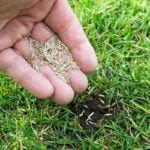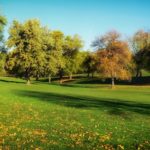
The Green Bay Packers, the winningest team in pro football, kicked off their 100th birthday Aug. 11 by dispersing souvenir seeds of the Kentucky bluegrass turf now under (spiked) foot on legendary Lambeau Field for fans to plant around the world to inspire the next generation of “cheeseheads.”

Seeds in hand, the fans then enjoyed free birthday cupcakes, souvenir patches and the first episode of the team’s new 10-part “Legacy” documentary, which chronicles the team’s history.
‘Part of the History’
Fan Tom Piering was delighted to receive a Blake Martinez autograph. “It’s part of the history of the field itself,” he told Spectrum News 1. “It’s part of the history of the stadium and the history of the team. To have a history of the team and have a player, it just makes it even better.”
Fans who missed the birthday party can purchase packets of Rooted in History Lambeau seeds for $5 at the Packer Pro Shop or online, with 100% of the purchase price going to the American Red Cross.
Fan Nathan Plitzweit hurried to post his personal seeding plans on social media, tweeting: “I’m going to pick up some Lambeau turf seed. I am then going to take a tour of US Bank Stadium (home of the Minnesota Vikings) & Soldier Field (home of the Chicago Bears) and drop some of the grass seed while on the field so it’s just like home for the Packers. That’s how it works, right?” He accompanies the post with a menacing photo of George Clooney peering up from a coastal grass line.
Sharing the Turf
Like many pro and college football teams, the Packers have shared souvenir chunks of turf with fans in the past, most notably in 1997 when Lambeau underwent a complete sod lift. But this year, the Pack updated its field-sharing fan favorite by adding a new twist that allows cheeseheads across the hemisphere to share the fun.
When you register your seed packet by ZIP code, an online interactive map adds you to all the miniLambeaus about to be planted. To date, Lambeau seeds have been registered in 49 of the 50 states (West Virginia is the lone no-sew so far) and as far away as Puerto Rico.
Not Suitable for Ice Bowling
Speaking of location, Packer gardening fans may have taken note on the back of their seed packet where it says that the enclosed Kentucky bluegrass blend “prefers soil temperature between 52 and 62 degrees.” That’s at least 65 degrees warmer than the weather during the infamous 1967 Ice Bowl, in which legendary Packer quarterback Bart Starr overcame a -13F/36 below zero game temperature at Lambeau to defeat the Dallas Cowboys and earn the Packers their third straight NFL championship.
How the heck does the bluegrass of Kentucky stay so green and flexible in frigid Lambeau Field? Well, as with many professional sports fields today, it has been given a little help by modern technology. In 2007, Lambeau upgraded its grass field to a more wear- and weather-tolerant hybrid from GrassMaster, which it recently upgraded to British-made SISGrass in 2018.
Lambeau’s Modern Sod
The new, improved playing surface starts with 3,500 tons of sand— roughly 170 dump trucks. The sand was placed over the drain tile and heating grid on the field’s subfloor. The SIS reboot then added a new laser-graded layer of pea gravel. That shortens the turf’s root zone depth from 12-13 inches to 10-11, bringing the heat pipes closer to the surface. After sodding the new Kentucky bluegrass, crews stitched in 2,500 miles of synthetic fiber ¾ inch from each other and 7 inches deep. The fibers stick up just above ground and serve to stabilize the sand base. Thus Lambeau became the first American pro football stadium with SISGrass.
“The whole driver of everything is we want a sand-root zone,” fields manager Allen Johnson told Packers.com. “The only way to get good drainage is to have straight sand, but when you have sand, sand in itself isn’t that stable. Picture the beach and then picture our growing season and 300-pound guys pushing on each other. The grass is going to wear and (you need) something to help stabilize the sand and give it some insurance.”
So while your Kentucky bluegrass seeds, once grown, won’t necessarily withstand the constant tromping of pro linebackers, they will serve as a pleasant visual tribute to the turf that stood its ground on the Lambeau Field that was.






